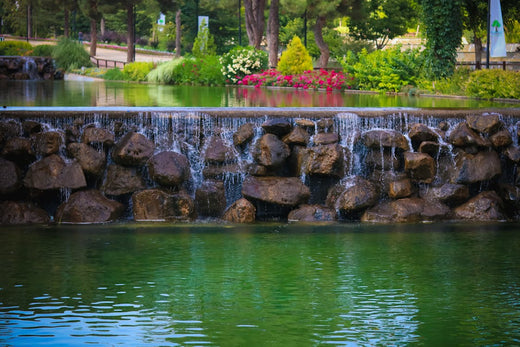Introduction
Have you ever paused by a body of water, wondering whether it's a lake or a pond? While both are serene gatherings of water, significant differences exist between the two. Exploring the difference between a pond and a lake satisfies curiosity and enhances our understanding of their ecosystems. This article will dive deep into the difference between ponds and lakes and their characteristics, from size and depth to ecological roles, helping you identify and appreciate these natural wonders. Join us to unravel these aquatic mysteries with Smith Creek Fish Farm’s insights.
What is a Pond?

A pond is a small body of still water smaller than a lake and typically shallow enough for sunlight to reach the bottom. This characteristic allows ponds to support diverse aquatic plants and wildlife, from floating lilies to darting fish. Often artificial or occurring naturally, ponds can be found in garden settings as tranquil features or in wild landscapes as essential habitats for biodiversity. By using the right pond supplies like pond aerators, pond fish food, pond filters, pond beneficial bacteria, and pond cleaning tools, you can beautify spaces and create sustainable environments for various species.
What is a Lake?

Lakes are larger inland bodies of water, typically more profound and extensive than a pond. Lakes can support various ecosystems, providing a habitat for numerous fish species, aquatic vegetation, and living creatures. They are crucial for biodiversity and serve multiple recreational purposes like fishing, boating, and swimming. Lakes can be formed through geological events such as glacial retreats or volcanic activity, creating unique environments requiring specific management practices, such as lake aeration, to maintain ecological balance and water quality.
Difference Between Lake and Pond
Size and Depth
The most notable difference between lakes and ponds is their size and depth. Lakes are generally much more extensive and more profound than ponds. While ponds are shallow enough for sunlight to reach the bottom, allowing aquatic plants to grow throughout, lakes have deeper zones where sunlight does not penetrate, creating stratified temperature layers. This size difference affects the ecology and the types of activities these bodies of water can support.
Origin and Formation
Lakes often form in depressions caused by glaciation, tectonic activity, or cratering due to volcanic activity, making them typically larger and part of broader geographical processes. On the other hand, ponds may form through more localized events such as minor flooding and can be artificially created by damming smaller bodies of water or excavating land.
Type of Water
Ponds usually contain fresh water and are often stagnant, with limited outflow, which can lead to higher levels of nutrients and algae. Lakes can be freshwater or saltwater, like the Great Salt Lake or Lake Superior, and generally have significant inflow and outflow, maintaining cleaner water with less stagnation.
The Nature of Reservoirs
While both lakes and ponds can act as reservoirs, their functions differ. Lakes are often vital sources of drinking water and irrigation due to their larger volumes and colder, deeper waters, which are less susceptible to pollution. People use ponds for livestock watering, irrigation, or pond fountains.
Type of Feeding
Lakes and ponds differ in their "feeding" or how they receive water. Many lakes often have rivers and streams feeding into them, supporting a dynamic ecosystem with richer biodiversity. Ponds typically gather water from runoff and depend more on rainwater, leading to a more isolated ecological system.
Bottom Illumination
The depth of a lake restricts sunlight penetration to the bottom, making the lower layers cold and dark, which affects the types of organisms that can survive there. Ponds, being shallower, usually have well-lit bottoms throughout, promoting abundant plant life and microorganisms.
Microorganisms
Due to their depth and cooler temperatures, most lakes house different types of microorganisms than ponds. Ponds, with their warmer and nutrient-rich environments and sizeable photic zones, i.e., zones with high light penetration, often support a higher density of algae and bacteria, influencing the overall health and oxygen levels in the water.
Environmental Importance
Both lakes and ponds play critical roles in their environments but on different scales. Lakes are crucial for regional ecosystems and human populations, supporting larger-scale biodiversity and providing resources for multiple communities. Ponds, while smaller, are incredibly important at the local level, enhancing landscape diversity, supporting wildlife, and providing habitats for various plant species.
What are the Benefits of Lake and Pond?

Lakes and ponds are more than just scenic elements in our landscapes; they are vital ecological assets. These water bodies provide essential habitats for diverse wildlife, from fish to migratory birds, contributing significantly to biodiversity. They serve as crucial water sources for agricultural irrigation and recreational activities like fishing, boating, and swimming, and they support local economies through tourism and sports. Additionally, lakes and ponds play a crucial role in hydrological cycles, helping to regulate water flow and filter pollutants, thus maintaining water quality and ecosystem health. Their presence can also enhance property values, offering aesthetic and recreational benefits to communities.
Conclusion
Understanding the differences between a lake and a pond enriches our appreciation for these aquatic systems and highlights the importance of preserving such vital natural resources. Whether it's a sprawling lake that spans miles or a quaint pond that nurtures local wildlife, both play indispensable roles in our environment. By recognizing and valuing their unique characteristics and benefits, we can better support conservation efforts to protect and sustain these water bodies for future generations, ensuring they continue to provide ecological, recreational, and economic benefits to our communities.

